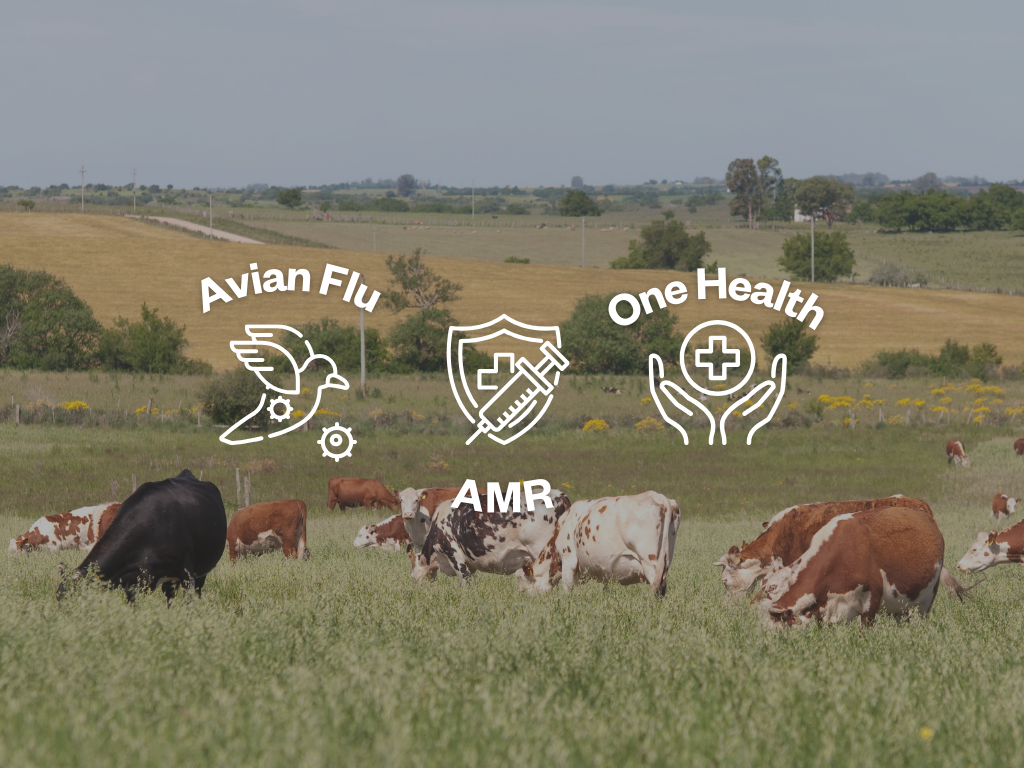Bird Flu, AMR, and Livestock, Oh My!
Bird flu and antimicrobial resistance have been the stars of recent global health headlines. And while seemingly unrelated at first glance, these two issues have far more in common than you may think.

Avian influenza (also referred to as H5N1 or “bird flu”) and antimicrobial resistance (AMR) are more and more prevalent in the current global health discourse. And while bird flu, livestock health, and AMR may seem like separate issues at first glance, they are actually closely interconnected. The rise of infectious diseases like bird flu and the widespread use of antibiotics in both human and animal populations are contributing to a dangerous global health crisis. Addressing these issues requires a comprehensive, integrated approach—a “One Health” approach—which recognizes that human, animal, and environmental health are all closely intertwined.
Bird Flu’s Impact on Livestock and Humans
Avian influenza, widely known as bird flu, is a viral infection that primarily affects, well, birds—but it can also infect other animals, from livestock to humans. The H5N1 strain of avian influenza type A virus has caused significant outbreaks in poultry farms across the world and is now a global public health concern.
Just this month, the United States saw its first human death at the hand of bird flu. And the increasing magnitude for exponential zoonotic transmission, or the spread of diseases from animals to humans, is at heightened risk. Now that the disease has made the jump to humans, concerns are mounting about the potential increase of human-to-human transmission and the risk of a pandemic.
Moreover, when bird flu spreads through poultry populations, it can require the large-scale culling of infected animals to prevent further transmission. This disruption not only threatens public health, but also jeopardizes food security and has significant economic consequences for farmers and the wider agricultural sector.

The Rise of Antimicrobial Resistance
In response to animal diseases, including the avian flu, farmers often turn to antibiotics and other antimicrobial drugs to control bacterial infections in livestock. While these drugs are sometimes needed to keep animals healthy, their overuse and misuse—for example, preemptively giving livestock low doses of antibiotics to reduce infection and enhance growth—have contributed to an alarming rise in antimicrobial resistance (AMR) and superbugs.
AMR is a naturally occurring phenomenon in which bacteria and other pathogens evolve to become resistant to the drugs designed to kill them. Despite AMR being a property of all pathogens, the global rise in antibiotic use in both humans and animals is exacerbating the issue, making infections harder to treat and increasing the risk of disease spread. The World Health Organization has described AMR as one of the biggest threats to global health, food security, and development today.
When antibiotics are used excessively in animals, resistant bacteria can develop and potentially transfer to humans via contact with animals, consumption of their contaminated meat, or exposure to contaminated water or soil. This breeds a dangerous cycle: as AMR spreads, it reduces our ability to treat both human and animal infections, leading to more illness that necessitates the use of antibiotics, and the loop continues.
Vaccines as a Key Player
As we know, vaccines are an essential tool for reducing overall reliance on antibiotics. Vaccines can help prevent disease and its secondary complications in both animals and humans, thus decreasing the need for antibiotics, and in turn slowing the development of resistance. This is a particularly important concept in areas where the overuse or misuse of antibiotics is common and the stakes are high for both animal and human health.
The One Health Approach
The “One Health” approach, coined by the World Health Organization, is a new paradigm for addressing the interrelated issues of animal health, human health, and the health of the environment. This integrated approach recognizes that diseases like bird flu do not solely affect animals or humans in isolation—instead, we are all part of a larger ecosystem. Infections in animals can affect humans, the health of both humans and animals is deeply influenced by the environment, and human action affects environmental health.

To effectively tackle public health issues like AMR, bird flu, and other zoonotic diseases, health professionals, environmental scientists, and policymakers alike must collaborate across their respective sectors. This holistic approach includes the monitoring and surveillance of animal and human populations to detect early signs of disease, responsible antibiotic use to reduce AMR risk, the promotion of sustainable farming practices to minimize the need for antibiotics, and overall global cooperation to establish all these practices as routine. Public health continues to illustrate that no issue exists in a vacuum, but vaccination remains a key strategy within the “One Health” approach to safeguard all three spheres of health.
In Short: It’s All Connected
The connections between avian influenza, livestock health, and antimicrobial resistance highlight the need for a unified approach to global health challenges. Vaccines can play a crucial role in the prevention of diseases like bird flu and the emergence of resistant pathogens, but they are ultimately just one crucial element of a much larger systemic solution.
But by taking a coordinated, evidence-based approach to vaccine development, antibiotic use, and environmental sustainability, we can safeguard our future from the threat of emerging infectious diseases. The time to act is now, and the responsibility lies with us all—from farmers to policymakers, scientists to consumers—to ensure a healthier, safer world for all.


